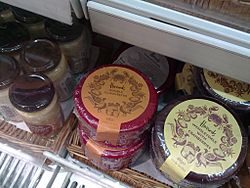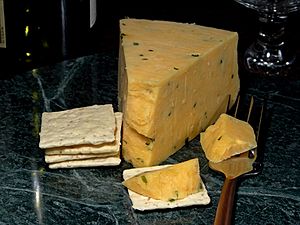Gloucester cheese facts for kids
Quick facts for kids Gloucester |
|
|---|---|
 |
|
| Country of origin | England |
| Region, town | Gloucestershire |
| Source of milk | Traditionally from Gloucester cattle |
| Pasteurised | Traditionally no |
| Texture | semi-hard |
| Aging time | 36 weeks |
| Certification | Single Gloucester: PDO |
Gloucester is a traditional, semi-hard cheese that has been made in Gloucestershire, England, since the 1500s. There are two types of this cheese: Single and Double. Both are traditionally made from milk from special Gloucester cattle.
Both types of Gloucester cheese have a natural rind (the outside layer) and a firm texture. Single Gloucester is more crumbly and lighter. It also has less fat. Double Gloucester is aged for a longer time. This gives it a stronger and more savory taste. It is also a bit firmer. The plant called Lady's Bedstraw (Galium verum) used to give Double Gloucester cheese its special yellow color.
Today, Double Gloucester is sold more widely in the United Kingdom. Both types are made in round shapes. However, Double Gloucester rounds are larger. In the past, Double Gloucester was a highly valued cheese. It was considered as good as the best Cheddar or Cheshire cheese. It was even sent to other places. Single Gloucester, though, was mostly eaten only within Gloucestershire.
Most Double Gloucester sold in UK supermarkets is "slab cheese." This means it's made in large factories called creameries. Big dairy companies often run these creameries. Supermarkets usually sell Double Gloucester under their own store brand name. This version of the cheese is pasteurized, which means it has been heated to kill germs. However, it is not processed cheese, which is made by mixing cheese with other ingredients.
Contents
Bringing Back Gloucester Cheese
Making traditional Gloucester cheeses from the Gloucester cow almost stopped in the 1950s. This was because most of the Gloucester cattle had disappeared. But in 1973, a person named Charles Martell found three old Gloucester cows. There were fewer than 50 left in the whole county. A BBC TV show called "A Taste of Britain" filmed his successful try to bring back the tradition of making farmhouse Double Gloucester that year.
In 1978, Charles Martell also brought back the lost Single Gloucester cheese. Traditional Gloucester cheese has been supported by the Slow Food movement since 2004. This movement helps protect local food traditions. Single Gloucester cheese now has a special status called Protected Designation of Origin (PDO). This means it can only be made in Gloucestershire on farms that have Gloucester cows. As of 2010, six cheese makers were producing this special cheese.
Different Kinds of Gloucester Cheese
Double Gloucester is often mixed with other ingredients to create new flavors. One type is made by blending it with chives and spring onions. This cheese has been sold as Cotswold cheese. However, "Cotswold" is not a traditional English cheese name. This cheese is said to be colored like the famous Cotswold stone.
Another interesting cheese is Huntsman cheese. It is also known as Stilchester. This cheese is made with layers of Double Gloucester alternating with layers of Stilton.
Why "Single" and "Double"?
The exact reason why the two types of Gloucester cheese are called 'double' and 'single' is not fully known. Here are the main ideas:
- Some think it's because the rich milk had to be skimmed twice to make the double variety.
- Another idea is that cream from the morning milk was added to the evening milk.
- A third theory is that a Double Gloucester cheese is typically twice as tall as a Single Gloucester.
The Famous Cheese Roll!
Double Gloucester cheese is also used every spring for a very exciting event. It's called the Cooper's Hill Cheese-Rolling and Wake. In this event, people chase a cheese down a very steep hillside in Gloucestershire. The first person to reach the bottom of the 200-yard (180-meter) slope wins the cheese! The hill is so steep, it's a 50% gradient.
See also
 In Spanish: Queso Gloucester para niños
In Spanish: Queso Gloucester para niños


